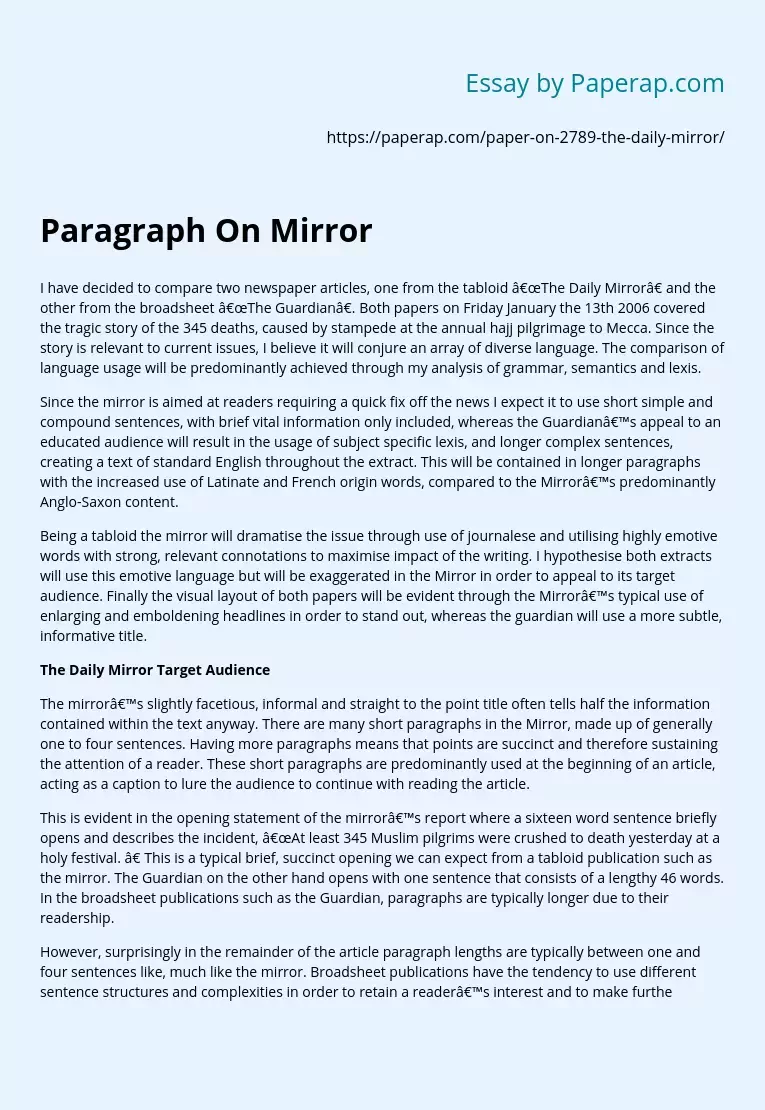Daily Mirror Target Audience
I have decided to compare two newspaper articles, one from the tabloid “The Daily Mirror” and the other from the broadsheet “The Guardian”. Both papers on Friday January the 13th 2006 covered the tragic story of the 345 deaths, caused by stampede at the annual hajj pilgrimage to Mecca. Since the story is relevant to current issues, I believe it will conjure an array of diverse language. The comparison of language usage will be predominantly achieved through my analysis of grammar, semantics and lexis.
Since the mirror is aimed at readers requiring a quick fix off the news I expect it to use short simple and compound sentences, with brief vital information only included, whereas the Guardian’s appeal to an educated audience will result in the usage of subject specific lexis, and longer complex sentences, creating a text of standard English throughout the extract. This will be contained in longer paragraphs with the increased use of Latinate and French origin words, compared to the Mirror’s predominantly Anglo-Saxon content.
Being a tabloid the mirror will dramatise the issue through use of journalese and utilising highly emotive words with strong, relevant connotations to maximise impact of the writing. I hypothesise both extracts will use this emotive language but will be exaggerated in the Mirror in order to appeal to its target audience. Finally the visual layout of both papers will be evident through the Mirror’s typical use of enlarging and emboldening headlines in order to stand out, whereas the guardian will use a more subtle, informative title.
The mirror’s slightly facetious, informal and straight to the point title often tells half the information contained within the text anyway. There are many short paragraphs in the Mirror, made up of generally one to four sentences. Having more paragraphs means that points are succinct and therefore sustaining the attention of a reader. These short paragraphs are predominantly used at the beginning of an article, acting as a caption to lure the audience to continue with reading the article.
This is evident in the opening statement of the mirror’s report where a sixteen word sentence briefly opens and describes the incident, “At least 345 Muslim pilgrims were crushed to death yesterday at a holy festival. ” This is a typical brief, succinct opening we can expect from a tabloid publication such as the mirror. The Guardian on the other hand opens with one sentence that consists of a lengthy 46 words. In the broadsheet publications such as the Guardian, paragraphs are typically longer due to their readership.
However, surprisingly in the remainder of the article paragraph lengths are typically between one and four sentences like, much like the mirror. Broadsheet publications have the tendency to use different sentence structures and complexities in order to retain a reader’s interest and to make further explanation of a point more coherent. In spite of this I have identified a range of sentence structures in both articles. Generally though, the guardian uses compound and complex sentences, while complex sentences are less common in the mirror, making it easier to read. The second paragraph in the mirror states,
“Around 1000 others were injured- at least two of them Brits-as people surged towards the Jamarat Bridge in mina, Saudi Arabia for a stoning ritual during the annual Hajj” furthering the single sentence paragraphs that are evident in the mirror. However this is a complex structure, the other stereotypical sentence structure I expected to see in the Mirror. These complex sentence structures from the Mirror were unexpected as the use of the sub-ordinate clause elaborates upon the main clause giving the story more detail therefore sensationalising the incident making it more interesting for the readers.
Furthermore in this quotation hyphens are used on two occasions to break up the text. This gives the text pause like features similar to the qualities of speech, these pauses hold the text back creating tension and suspense, subsequently dramatising the depiction of the event even further than the choice of sentence structure. The Guardian also typically uses a complex sentence structure with subordinate clauses for its first sentence to add detail-
“Thousands of Muslim pilgrims rushing to the complete a symbolic stoning ritual during the annual hajj tripped over baggage yesterday, causing a crush in at least 345 people were killed and hundreds injured, despite Saudi attempts to prevent stampedes that have plagued the annual event. ” This single complex sentence forces the reader to endure a brief but informative sentence about the incident and then makes them want to read further as it shows the article will contain useful knowledge of the incident as the sub-ordinate clause in the complex structure adds this detail.
Neither piece contains many “co-ordinators” in the transcripts despite them being typical to a tabloid’s write up. “Co-ordinators” are used predominantly at the beginning of sentences for example “but… ” to reflect speech patterns, and as these are less formal grammatical structures they maintain momentum throughout an article. The mirror uses it at the start of a paragraph to divert attention to a new point- “But West Yorks assistant chief constable… ” this is the contrary to what you would expect in the guardian as co-ordinators are less formal hence the use of grammatically complete sentences in the Guardian.
Adverbials are used at the start of sentences to change the focus yet keep the reader involved. They can be used for example by writing “meanwhile” or on the other hand the Guardian typically uses adverbials in a variety of positions depending on the emphasis most appropriate to the meaning. In the guardian’s sentence- “This year’s event was also marred by the collapse of another building… ” this is a more formal and subtle way of changing focus whereas the mirror would typically use “meanwhile” as it subtly includes added information and represents a similarity to informal speech that is easy to comprehend.
Daily Mirror Target Audience. (2019, Dec 05). Retrieved from https://paperap.com/paper-on-2789-the-daily-mirror/

